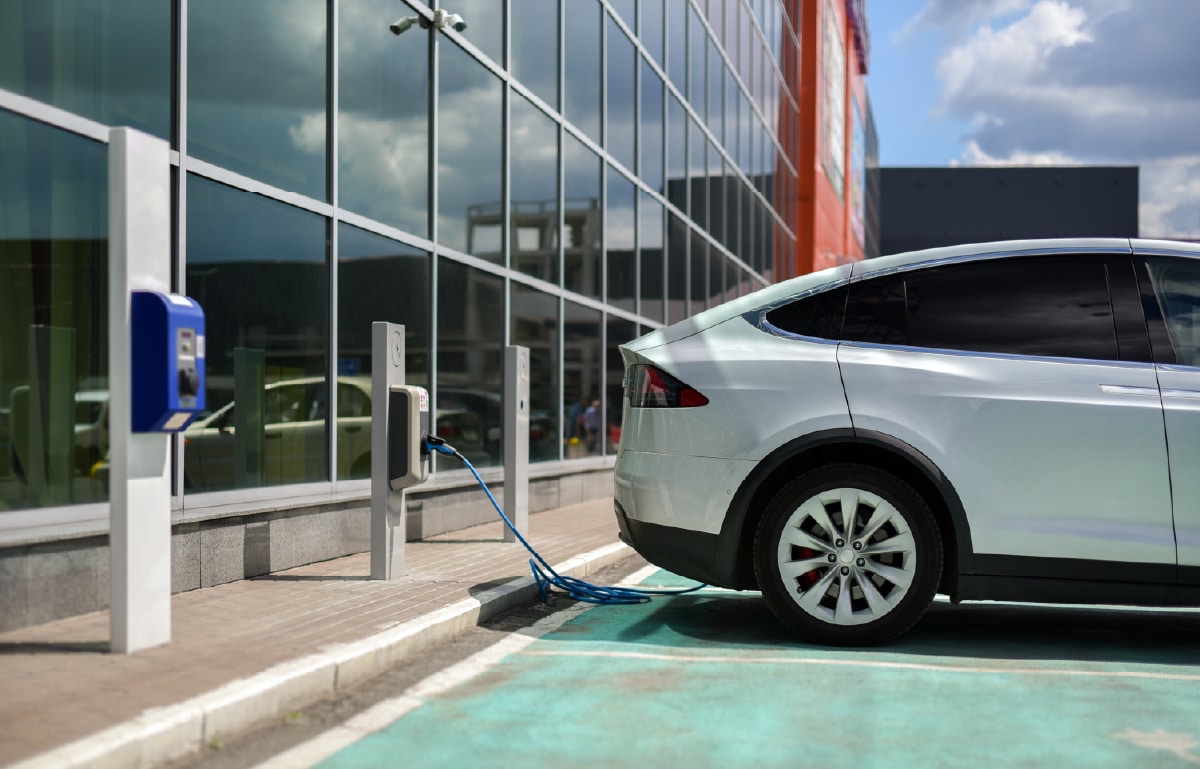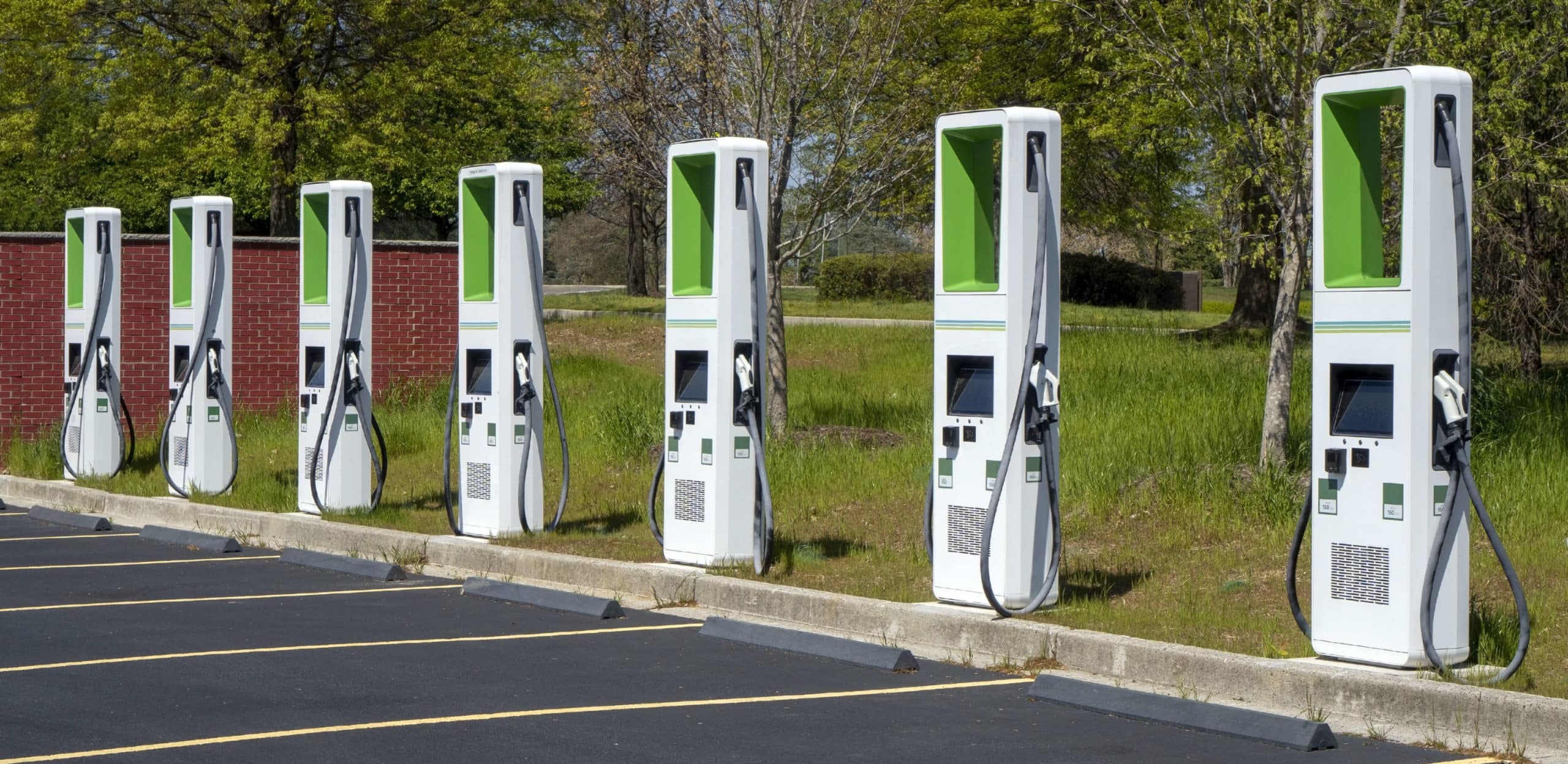- August 21, 2020
- Perspectives
COVID-19 Hasn’t Dimmed the Electric Vehicle Market’s Spark


Bryce Christensen, PE
Electric Vehicle Practice Lead

Ryan Gram, PE
Electric Vehicle Practice Lead

Bryce Christensen, P.E.
Electric Vehicle Practice Lead

Ryan Gram,
P.E.
Electric Vehicle Practice Lead
COVID-19 hasn’t slowed the demand for electric vehicle (EV) charging stations as EVs become more and more prevalent. Even as auto sales decrease, EVs remain on track to make up 58% of all new car sales by 2040. To prepare for this increase in EVs, land developers and Level 2 (L2) and Direct Current Fast Charger (DCFC) EV charging station designers are thinking outside the box about long-term charging solutions. From office parks to apartment complexes to retail locations, EV charging stations are being implemented to meet increased demand, new legislative requirements, and corporate sustainability goals. Below, Kimley-Horn’s Bryce Christensen, PE, and Ryan Gram, PE, address commonly asked questions, share how to streamline the EV charging station development process, and discuss new industry trends and applications amid the COVID-19 pandemic.
Will installing EV charging stations at offices remain a priority for employers, especially since more people are now working from home?
EV charging stations are becoming a key separator for companies because many employees see them as a highly sought-after amenity. Though more people are working from home today and office EV charging stations are being used less frequently, we believe this dip in usage will be temporary. Many companies are anticipating, planning, and undergoing a return to work from offices.
As the consumer demand for EVs becomes greater with more models available at affordable prices, the need for EV charging stations in office spaces is only going to grow. Potential new hires may be enticed to join companies with this benefit. When some companies reopen at limited capacity where it’s safe to do so, access to charging stations may also help incentivize employees with EVs to return to offices a few days a week.
EV charging stations are not just an employee benefit though—they also help companies meet corporate sustainability goals. Additionally, jurisdictions and municipalities are starting to require that EV infrastructure be implemented on the street and in garages, making providing EV charging options a requirement for some developers.

Will there be an increased demand for L2 and DCFC at retail locations? Will retailers add more to attract customers?
Retailers are realizing that charging stations are not just amenities—while their cars are charging, people are spending time and money in stores. EV drivers will sometimes go out of their way to visit a retailer with charging stations. While there is some upfront investment, the payout for retail companies can be huge. Each charging station is like a gas station—while drivers fill their tanks, they may also visit the mini-mart on site. But, EV drivers charging up at a retail development have more expansive options like big-box stores to explore while they wait rather than a small convenience store. This is a key differentiator for the EV charging market: there is flexibility to add charging stations at any and all destinations. EV owners can conveniently charge where they already travel during daily trips instead of adding an additional stop at a gas station.
Due to COVID-19, the retail market is in flux, and many retailers are taking this time to redesign their brick and mortar locations. According to a recent International Council of Shopping Centers webinar, retailers are planning more grab-and-go and order-and-pickup options in their 2021 designs. They’re also considering how to reduce their carbon footprints and renting space in places they haven’t before, such as strip malls and outdoor malls. With these redesigns, there has been an increased interest from mall developers and supermarket chains in EV services.
With the increased popularity of online shopping, will people continue to charge at retail locations?
People are still driving. In fact, more people are traveling by car today than other modes of public transportation or air travel, as they feel safer in their own vehicles than in shared spaces. EV owners will continue to charge wherever charging is available, such as at retail locations. They rely on mobile apps to map driving routes based on charging station locations and often, retail charging station options are the most convenient and accessible. While online shopping is more popular now than ever before, we’re still seeing people seek charging stations out in shopping centers. There’s also a possibility that EV owners will be drawn to order and pick up from stores if they can charge while they wait.
How are charging stations a property differentiator for multifamily developers? How can they implement charging stations well and what trends are emerging?
Multifamily developers are learning that EV chargers are attractive to potential residents. If developers want to separate themselves from the competition, providing accessible EV charging stations can play a big role in making that happen. As the number of EV owners grows in the coming years, we anticipate people will strike properties off their lists if EV chargers are not readily available.
Charging Forward
We’re going to start seeing more EVs on the road as range and batteries improve. This market sector isn’t going anywhere but up. The exciting thing is that the electric vehicle market is still in its infancy compared to where it’s going to be in just a couple of years. There are tons of new EVs slated to come out in 2020 and 2021; the EV landscape will be completely different in 2023. The question is, which companies, retailers, and municipalities will be ready with the EV infrastructure to serve this growing market? Only time will tell…
Want to learn more about implementing EV charging stations? Contact Bryce Christensen or Ryan Gram.
About the Authors

Bryce Christensen, PE
Bryce is a senior partner on nationwide EV programs and has worked on 200 EV charging station sites across the county—including parts of one of the first coast-to-coast EV charging routes. He has a true passion for EV and a strong desire to see sensible infrastructure development and public education in this space. Bryce’s expertise includes EV charging station design, site planning and layout, grading and drainage design, erosion control, stormwater management system design, utility design, permitting, construction observation, pavement assessment and rehabilitation, parking assessments and planning, and site/stormwater inspections. Additionally, his project portfolio includes single and multifamily residential, retail, healthcare, office, and mixed-use commercial developments. Bryce takes great pride in serving his clients and partners to help ensure the success of each project he works on.

Ryan Gram, PE
Ryan is recognized as a leading authority in EV charging stations and is currently leading or partnering on three nationwide EV programs. In less than 5 years, he has worked on more than 600 EV charging station sites across the country. Ryan is passionate about innovative design solutions, alternative energy, creative stormwater management, and grading implementation. His background reflects a variety of energy, industrial, residential, retail, commercial, and mixed-use land development projects that have included preliminary site planning and feasibility studies, grading and drainage design, utility (sewer, water, and conduit) design, stormwater management, pollution prevention, and construction support services. He enjoys when his skills come together to provide developments where people want to live, work, and play all while being able to conveniently access EV charging.
